
When and How to Use Neem Oil to Control Pests
Neem oil is an almost magical compound in your garden for preventing pests, fungus, and bacteria. Epic Gardening founder Kevin Espiritu shares how it works and application tips!

Neem oil is an almost magical compound in your garden for preventing pests, fungus, and bacteria. Epic Gardening founder Kevin Espiritu shares how it works and application tips!

Wilting seedlings got your down? Luckily, there are many ways to prevent damping off disease from taking over. Kevin Espiritu explains the causes behind this common disease and how you can prevent it.

Are there suddenly holes in the leaves of your favorite plants? A common culprit is the Japanese beetle. Kevin Espiritu explains how to identify and control these invasive bugs.

Grasshoppers decimate a garden quickly if not controlled. Learn how to kill grasshoppers and prevent them from attacking in this guide by Kevin Espiritu.

Garlic spray is one of the cheapest and most eco-friendly ways to treat pests and plant diseases. Epic Gardening Founder Kevin Espiritu explains why it works, how to make your own, and how to use it.